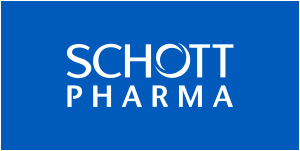Schott unveiled a new concept for ready-to-use pharmaceutical vials at this week's CPhI.
The German glassmaker also launched Vials DC with a minimised risk of delamination.
Schott adaptiQ consists of a nest and tub configuration that allows for 100 vials to be securely fixed inside a holder (nest) and delivered to pharmaceutical companies packaged in a sterile container. The vials can then be filled immediately without having to perform further processing steps such as washing, drying and sterilisation.
Gregor Deutschle, Product Manager, Sterile Vials and Cartridges at Schott, said the patented nest design allows vials to be subjected to all of the processing steps while inside the nest, including freeze-drying, weighing and closing.
'As well as simplifying the process, the glass containers can no longer come into contact with each other or be scratched by machine components,' he said. 'Nests can also be connected together to build a small train, making them easy to load into a freezer/dryer.'
The vials can be inserted from the top or the bottom of the nest and held in place with a special plastic hook that fits around the neck of the vial. This securely fixes them inside the nest so that they cannot tip over, fall out, or knock into each other, meaning that there are fewer rejects during the filling process.
Deutschle said adaptiQ offers a number of advantages to improve efficiency.
As well as simplifying the process, the glass containers can no longer come into contact with each other
'If pharmaceutical companies can use the same production line for various lot sizes and different types of containers like syringes, vials and cartridges, this gives them much greater freedom to react to new market demands more quickly,' he said.
'Moreover, costs can be lowered by shortening the process chain and reducing its complexity. It is then no longer necessary to invest in cleanrooms, special washing machines and sterilisation tunnels, or spend money to operate them.'
Schott says roughly 80% of all pre-filled syringes sold globally today are delivered to filling lines in the form of a nest and tub configuration. Attempts to apply this approach – originally developed for syringes – to other types of containers have failed in the past because vials still had to be individually removed from the nest for certain processing steps.
The patented, new nest design on which adaptiQ is based offers a solution to this problem for the first time. The vials are held by the neck and can all be lifted up or out of the nest together. Furthermore, the bottom is freely accessible and thus ensures the perfect temperature transition, especially during lyophilisation.
AdaptiQ is scheduled to be launched in the third quarter of 2014, starting with the most popular 2R and 4R ISO formats. It is expected to be gradually introduced in all of the most common ISO formats ranging from 2 to 30ml. Initial samples will be available from the end of this month.
Schott also unveiled Vials DC – a pharmaceutical vial that allows the risk of delamination (where flakes peel off from the inner glass surface of a vial as the result of interaction with the formulation and/or medication) to be determined based on threshold values.
Schott monitors these values over the course of the manufacturing process and is thus able to minimise the risk of delamination. The company says it has been able to optimise its manufacturing process to ensure that Vials DC have a more homogeneous surface, hence offering high chemical stability.
Schott has also developed a patented test method, known as the Delamination Quicktest, which allows for this lower tendency to delamination to be documented.
Dr Bernhard Hladik, Head of Product Management, says with the Delamination Quicktest, a certain number of vials are removed from every batch. The random samples are then subjected to stress for four hours inside an autoclave to tease out the delamination critical zone. In a second step, the vials are filled with high purity water (WFI – Water for Injection) and sodium is extracted inside an autoclave. The volume of sodium extracted correlates with the probability that the vials will experience delamination at a later point in time. By monitoring these values and adhering to certain threshold values, Schott is now able to control the risk of delamination.
Vials DC will be available in 2R to 10R ISO formats starting at the beginning of 2014.





